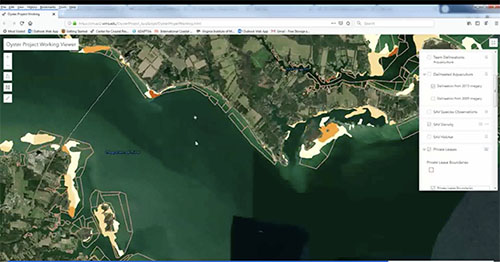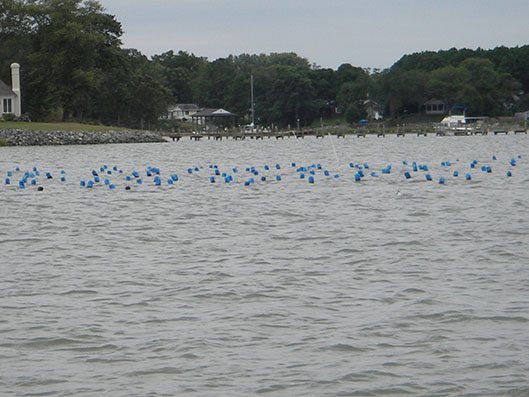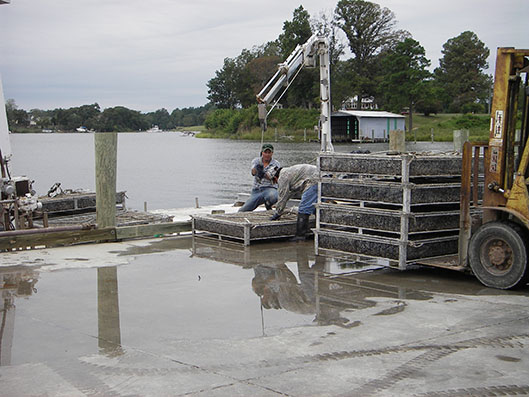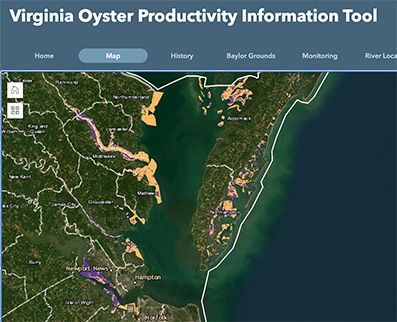Aquaculture in Virginia
The most rapid expansion of the aquaculture industry in Virginia has been in hatchery-based production of cage-cultured oysters on private grounds. Conflicts have arisen between new user groups residing along the Chesapeake Bay shore, and a growing industry that works primarily in nearshore waters. Additionally, as the shoreline has been developed, there are very limited access points along the waterfront where commercial activity can occur.
This study has characterized the oyster industry as it exists today, examined the regulatory framework, and closely examined major issues that impact future expansion. Over three consecutive years the project has examined opportunities and conflicts to aquaculture expansion associated with three major areas:

- Productivity of public oyster grounds known as Baylor Ground
- Productivity within privately leased subaqueous bottom
- Shallow water use conflicts: submerged aquatic vegetation (SAV), waterfront view-shed
Methods
The majority of this study was conducted within the framework of GIS and used geospatial data from mapping and monitoring databases collected over many years. The principal sources for data that supported this project include: the VIMS VOSARA database, the VIMS/CCRM Bottom Type database after Havens et al, 1981, the VMRC Harvest Reporting database, the VIMS SAV Mapping database, the VMRC Baylor Ground delineation, VMRC Private Lease database, and the NOAA Topobathymetric database. These data were used to map, model, and assess environmental condition, productivity on public grounds, management boundaries, ecological conflicts, and the spatial distribution of cultured oyster productivity as indicated by harvest productivity. The purpose of these assessments was to determine if there was opportunity for aquaculture expansion in Virginia within the current boundaries constrained by public and private grounds without generating new or added conflict.
Products
- Virginia Oyster Productivity Information Tool (2021) - An Interactive Platform with Information and Maps
- Expanding Virginia’s oyster industry while minimizing user conflict (2018 report)
- Expanding Virginia’s oyster industry while minimizing user conflict (2019 report)
- Expanding Virginia’s oyster industry while minimizing user conflict: future prospects (VA Aquaculture Conference)
- SAV Density in Oyster Project Areas (Video Presentation)
Project Phases
Year OneYear 1 examined current and future productivity of the public oyster fishery as well as an analysis of current use of private leased subaqueous bottom for aquaculture purposes. The data were updated in the final project year to reflect the most current data. The results indicated that only 22% of the public oyster grounds in the Virginia portion of the Chesapeake Bay are productive and suitable for restoration, and 15% of the roughly 48,000 acres on the seaside of the Eastern Shore of Virginia are productive and should be targeted for restoration. Year 1 also looked at the utilization of leased subaqueous bottom for the purpose of clam or oyster aquaculture between 2013-2019, as a function of the mandatory harvest reports submitted by lease owners. These results indicate that 63% of the area tied up in private leases were not reporting any activity. Both the under-utilized subaqueous bottom tied up in leases, combined with the unproductive areas tied up in Baylor could provide relief to the expanding industry as it strains to find suitable subaqueous real estate for expansion. A shift in policy or regulation would be required to move forward, and the project recommends the state considers allowing unproductive Baylor Ground to be used for intensive aquaculture and managing this use through the existing Joint Permit Program (JPA) process or some other permit or lease arrangement. The team recommends that updates to Baylor Ground boundaries should be subject to revision based on best available knowledge and mapping techniques. |
Year TwoYear 2 (2018-2019), examined the current and historic trends associated with the spatial arrangement of submerged aquatic vegetation and caged based, intensive aquaculture. The analysis addressed the short falls in the current regulatory structure which assumes aquaculture impedes growth and persistence of SAV.The analysis performed using SAV distribution data for several 5-year clusters, and the corresponding harvest records for those years, indicate this assumption is not valid. For the most recent period of 2015-2019, 44% of all SAV beds are associated with intensive, caged based aquaculture. The results warrant a re-examination of the current regulatory restrictions associated with SAV and aquaculture, and the project recommends a structure similar to Maryland’s HB 841 which passed in 2019. |
Year ThreeYear 3 (2019-2020) expanded the analysis of public Baylor ground productivity to the seaside of the Eastern Shore of Virginia. Year 3 also expanded the analysis of shallow water use conflict to consider not only the ecological conflicts associated with expanding aquaculture, but also societal conflicts as the industry is forced into nearshore areas due to space limitations. Finally, in an effort to increase the capacity of industry members, regulators, and policy makers to make informed decisions, Year 3 has generated an interactive platform where information and maps can be reviewed and disseminated. |




